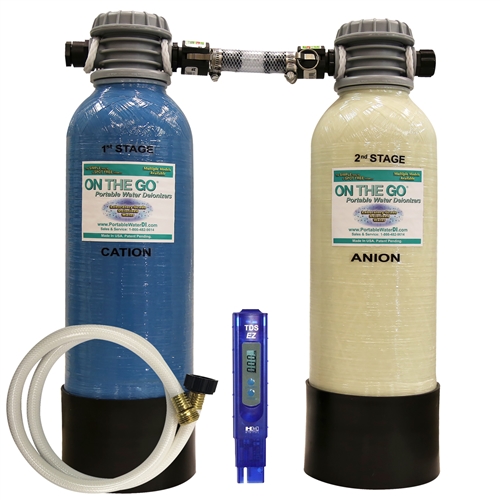 Depending on where in the country you live, hard water may be something you have to deal with at home. When you travel in your RV, the water quality always changes depending on where you are in the country, the water source, and even the local weather conditions. Some areas of the country have a higher concentration of minerals in the water than others, with 85% of the US experiencing hard water. The southwest, southeast, and Great Lakes region are all areas that have particularly hard water. Just like at home, however, there are several ways to ensure your water quality while in your RV.
Depending on where in the country you live, hard water may be something you have to deal with at home. When you travel in your RV, the water quality always changes depending on where you are in the country, the water source, and even the local weather conditions. Some areas of the country have a higher concentration of minerals in the water than others, with 85% of the US experiencing hard water. The southwest, southeast, and Great Lakes region are all areas that have particularly hard water. Just like at home, however, there are several ways to ensure your water quality while in your RV.
Let’s start with the exterior of your RV and the type of water you might have at home. When you’re washing your RV, hard water can leave spots on the outside if you don’t dry it off right away, which can eventually cause damage to the finish.
Water de-ionizers use an ion exchange process to remove positive and negative charged ions in the water by passing it through different resins. This allows you to let your RV dry naturally without the water leaving spots behind. One thing to remember when using an RV water de-ionizer as opposed to a water softener is that the de-ionizer is not made to purify water for cooking or drinking.
Now let’s move to the water inside your RV. If you’re regularly in areas that experience hard water, it can build up in pipes and on surfaces, affecting the water pressure. Mineral build-up from hard water inside the pipes reduces the amount of water that can pass through. You can also see in the form of soap scum, water spots, or calcium deposits on surfaces. This is where an
RV water softener comes in. Like a de-ionizer, a softener also uses resins to remove the ions that come from mineral substances in the water, like lime, calcium, and magnesium. Unlike a de-ionizer, which typically replaces them with hydrogen ions, a water softener usually replaces them with sodium ions.
While a water softener is the easiest way to deal with hard water, you can use a vinegar & water solution to remove minor hard water build-up in your RV’s plumbing. It is a similar process to winterizing your RV, in which a one part vinegar to one part water solution is first added to the fresh water tank, then pumped throughout your RV’s plumbing system until it’s worked through each fixture. Once it is in each fixture, the vinegar/water mix is left in the plumbing system for at least a few hours to break up any substances. Afterward, it is drained in a process similar to de-winterizing, with fresh water being run through the plumbing until the vinegar is gone.
In some cases, just softening your water may not be enough, or the issue may be other contaminants in your water. In these situations, water filtration is your best bet.
Water filters work to prevent substances from getting into your drinking water. Depending on your needs and budget, there are several types of water filters to choose from. There are under the sink models that work directly with your RV kitchen faucet, inline filters that hook up to a hose, as well as whole vehicle systems that can take care of all the water in your RV. Each has their own benefits. Inline and under-the-sink RV water filters are less expensive and are easy to hook-up, while whole vehicle systems can also work to remove chemicals and bacteria as well as sediment.
The last thing you want to worry about on an RV trip whether the water you’re using is safe. While dealing with varying water quality can be a challenge, it doesn’t have to be a hassle. With the right equipment, you can ensure that the water coming out of your RV’s plumbing is safe to use as well as being easy on the pipes.
Improving Water Quality for Your RV